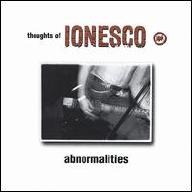The trio, whose collective mental stability was often called into question by even those close to them, was most often compared to My War-era Black Flag, mixing hatred and aggression with super-heavy riffs, free jazz exploration, a brutal live show, and hefty doses of nihilism, self-loathing, and pure masochistic rage to produce a sound wholly challenging and frequently misunderstood. Thoughts of Ionesco were in a class of their own; their performances were notoriously destructive -- instruments were smashed in minutes, walls were kicked in, blood was shed, bottles were thrown -- as the bandmembers showed absolutely no regard for themselves or the "fans" they couldn't be bothered to care about. For them, only the music mattered. They toured the country and Canada a few times over, most notably with their friends in Wallside, but due to the inaccessibility of their records, they remained obscure (though rather revered) upon their eventual implosion in 1999. Thoughts of Ionesco played their last show that November in Ann Arbor, MI.
Several years later, the guys reappeared on the Detroit music scene with new bands: Hoen in the Holy Fire and Leaving Rouge, Miller in the Holy Fire, and Repa with Paradise. Seventh Rule eventually collected the band's recorded output -- including releases on Makoto (1996's The Triptych Session, 1997's ...And Then There Was Motion, 1998's A Skin Historic, the last of which SPIN called "an art-core mindfuck") and At Arms Mechanic (1999's For Detroit, from Addiction, released 2001) -- into the compilation The Scar Is Our Watermark. Issued in June 2006, the album also included a bonus in-depth documentary DVD that chronicled the band's brief, volatile career with live footage and interviews. ~ Corey Apar, Rovi














